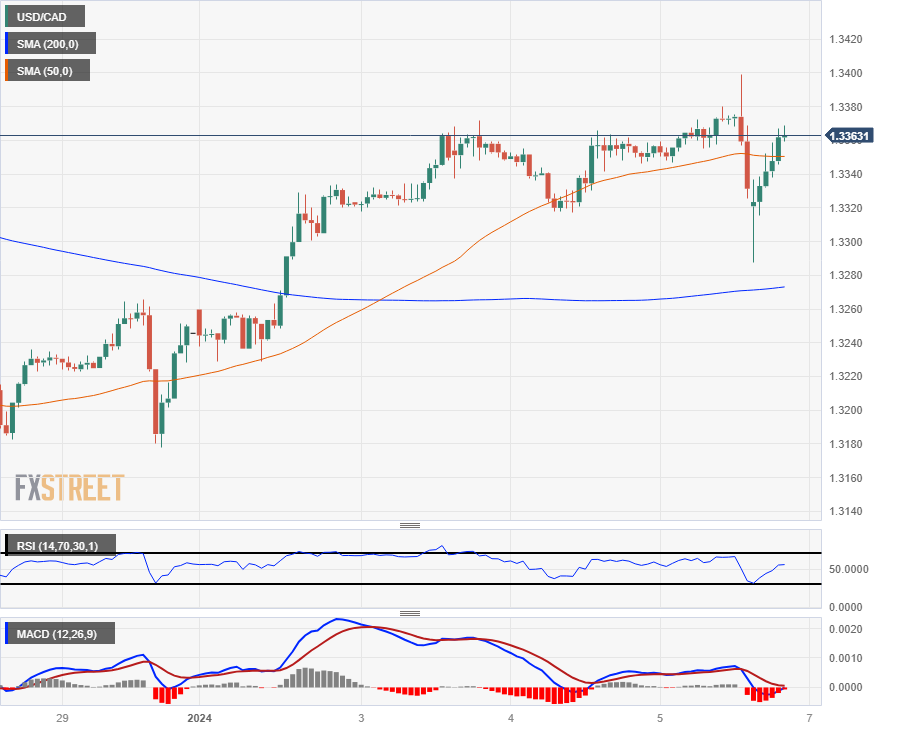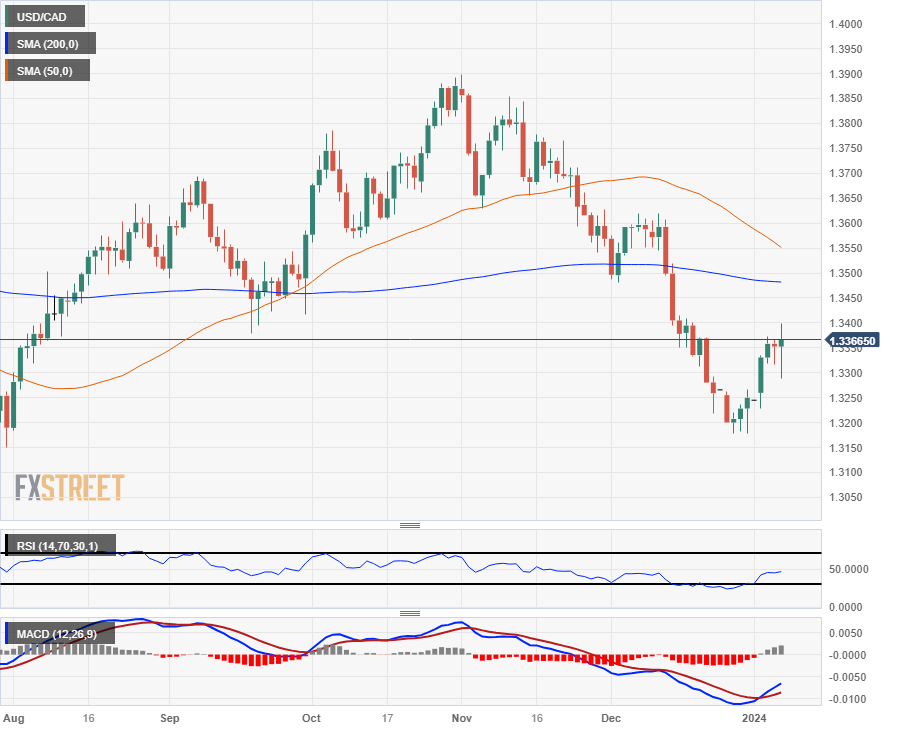Most recent article: Canadian Dollar backslides, dragged down by tumble in Crude Oil
- The Canadian Dollar is etching in a broad range on NFP Friday.
- Canada jobs additions crumble, US jobs easily beat the street.
- Despite weak labor figures, Canadian wage pressures persist.
The Canadian Dollar (CAD) slumped to a new low for the week against the US Dollar (USD) before surging to a three-day high as markets whipsaw after a bumper US Nonfarm Payrolls (NFP) report crushes market forecasts.
Canada saw a hamstrung labor market add fewer jobs than the margin of error on the figure itself, coupled with persistent wage growth that accelerated to a two-year high.
Daily digest market movers: Canadian Dollar churns, investors grapple with NFP print
- US Nonfarm Payrolls are dominating the headlines, adding 216K net new jobs to the US employment landscape in December compared to the 160K forecast.
- Despite the beat, revisions continue to plague the data, dragging November’s 199K down to 173K and October’s 150K getting revised even further lower to 105K.
- Average Hourly Earnings in the US ticked up slightly from 4% to 4.1% for the year ended December, and the US Unemployment Rate also held steady at 3.7% in December, where market forecasts expected a tick upwards to 3.8%.
- Despite the overall upshot in US data, the US ISM Services Purchasing Managers’ Index (PMI) in December broadly missed expectations, printing at a stunted 50.6 versus the forecast decline from 52.7 to 52.6.
- On the Canadian side, the Unemployment Rate held flat at 5.8%, snubbing the forecast 5.9%.
- Canadian Average Hourly Wages growth surged from 5.0% to 5.7% in December, a two-year high.
- Forecasts for Canadian Net Change in Employment completely missed the mark, with Canada adding a paltry 0.1K new jobs in December versus the forecast decline from 24.9K to 13.5K.
- Canadian December Ivey PMIs remain upbeat in the seasonally-adjusted figure, moving from 54.7 to 56.3, but cyclical factors are doing a lot of the heavy lifting, with the non-seasonally adjusted PMI slipping from 53.2 into contractionary territory at 43.7, a 12-month low.
Canadian Dollar price this week
The table below shows the percentage change of Canadian Dollar (CAD) against listed major currencies this week. Canadian Dollar was the weakest against the US Dollar.
| USD | EUR | GBP | CAD | AUD | JPY | NZD | CHF | |
| USD | 1.04% | 0.08% | 0.87% | 1.42% | 2.56% | 1.16% | 1.10% | |
| EUR | -0.90% | -0.80% | -0.03% | 0.53% | 1.53% | 0.28% | 0.15% | |
| GBP | -0.10% | 0.79% | 0.79% | 1.33% | 2.55% | 1.07% | 0.94% | |
| CAD | -0.89% | -0.02% | -0.63% | 0.52% | 1.68% | 0.26% | 0.17% | |
| AUD | -1.46% | -0.54% | -1.34% | -0.59% | 0.95% | -0.26% | -0.37% | |
| JPY | -2.62% | -1.54% | -2.48% | -1.53% | -0.99% | -1.28% | -1.57% | |
| NZD | -1.20% | -0.30% | -1.09% | -0.32% | 0.24% | 1.21% | -0.12% | |
| CHF | -1.05% | -0.15% | -0.95% | -0.15% | 0.40% | 1.51% | 0.16% |
The heat map shows percentage changes of major currencies against each other. The base currency is picked from the left column, while the quote currency is picked from the top row. For example, if you pick the Euro from the left column and move along the horizontal line to the Japanese Yen, the percentage change displayed in the box will represent EUR (base)/JPY (quote).
Technical Analysis: All that effort just to push the Canadian Dollar in a circle, USD/CAD returns to midrange
It’s a fundamentals-driven day for the Canadian Dollar, with NFP sparking an initial surge in the USD/CAD towards 1.3400 following the jobs release, however, markets quickly reversed course to plunge into 1.3290 before settling back into familiar territory near 1.3360.
Despite the US Dollar broadly falling against most of major currencies heading into the weekly close, the CAD is struggling to draw interest, underperforming all of its major currency peers, in the red across the major currency bloc and down a scant 0.07% against the Greenback.
With the USD/CAD pushing into the middle on Friday, the pair is at risk of a pause on the daily candlesticks, hung out to dry in no man’s land below the 200-day Simple Moving Average (SMA) at the 1.3500 handle while the 50-day SMA accelerates into a downside crossover of the longer moving average.
The Canadian Dollar wrapped up Friday's action down nearly nine-tenths of a percent against the US Dollar from Monday's opening bids, followed by two-thirds of a percent against the Pound Sterling and flat on the week against the Euro. On the top side, the CAD gained 1.7% against the Japanese Yen for the week, and climbed half a percent against the Aussie and a little over a quarter of a percent against the Kiwi.
USD/CAD Hourly Chart

USD/CAD Daily Chart

Canadian Dollar FAQs
What key factors drive the Canadian Dollar?
The key factors driving the Canadian Dollar (CAD) are the level of interest rates set by the Bank of Canada (BoC), the price of Oil, Canada’s largest export, the health of its economy, inflation and the Trade Balance, which is the difference between the value of Canada’s exports versus its imports. Other factors include market sentiment – whether investors are taking on more risky assets (risk-on) or seeking safe-havens (risk-off) – with risk-on being CAD-positive. As its largest trading partner, the health of the US economy is also a key factor influencing the Canadian Dollar.
How do the decisions of the Bank of Canada impact the Canadian Dollar?
The Bank of Canada (BoC) has a significant influence on the Canadian Dollar by setting the level of interest rates that banks can lend to one another. This influences the level of interest rates for everyone. The main goal of the BoC is to maintain inflation at 1-3% by adjusting interest rates up or down. Relatively higher interest rates tend to be positive for the CAD. The Bank of Canada can also use quantitative easing and tightening to influence credit conditions, with the former CAD-negative and the latter CAD-positive.
How does the price of Oil impact the Canadian Dollar?
The price of Oil is a key factor impacting the value of the Canadian Dollar. Petroleum is Canada’s biggest export, so Oil price tends to have an immediate impact on the CAD value. Generally, if Oil price rises CAD also goes up, as aggregate demand for the currency increases. The opposite is the case if the price of Oil falls. Higher Oil prices also tend to result in a greater likelihood of a positive Trade Balance, which is also supportive of the CAD.
How does inflation data impact the value of the Canadian Dollar?
While inflation had always traditionally been thought of as a negative factor for a currency since it lowers the value of money, the opposite has actually been the case in modern times with the relaxation of cross-border capital controls. Higher inflation tends to lead central banks to put up interest rates which attracts more capital inflows from global investors seeking a lucrative place to keep their money. This increases demand for the local currency, which in Canada’s case is the Canadian Dollar.
How does economic data influence the value of the Canadian Dollar?
Macroeconomic data releases gauge the health of the economy and can have an impact on the Canadian Dollar. Indicators such as GDP, Manufacturing and Services PMIs, employment, and consumer sentiment surveys can all influence the direction of the CAD. A strong economy is good for the Canadian Dollar. Not only does it attract more foreign investment but it may encourage the Bank of Canada to put up interest rates, leading to a stronger currency. If economic data is weak, however, the CAD is likely to fall.
Information on these pages contains forward-looking statements that involve risks and uncertainties. Markets and instruments profiled on this page are for informational purposes only and should not in any way come across as a recommendation to buy or sell in these assets. You should do your own thorough research before making any investment decisions. FXStreet does not in any way guarantee that this information is free from mistakes, errors, or material misstatements. It also does not guarantee that this information is of a timely nature. Investing in Open Markets involves a great deal of risk, including the loss of all or a portion of your investment, as well as emotional distress. All risks, losses and costs associated with investing, including total loss of principal, are your responsibility. The views and opinions expressed in this article are those of the authors and do not necessarily reflect the official policy or position of FXStreet nor its advertisers. The author will not be held responsible for information that is found at the end of links posted on this page.
If not otherwise explicitly mentioned in the body of the article, at the time of writing, the author has no position in any stock mentioned in this article and no business relationship with any company mentioned. The author has not received compensation for writing this article, other than from FXStreet.
FXStreet and the author do not provide personalized recommendations. The author makes no representations as to the accuracy, completeness, or suitability of this information. FXStreet and the author will not be liable for any errors, omissions or any losses, injuries or damages arising from this information and its display or use. Errors and omissions excepted.
The author and FXStreet are not registered investment advisors and nothing in this article is intended to be investment advice.
Recommended content
Editors’ Picks

EUR/USD stays near 1.0400 in thin holiday trading
EUR/USD trades with mild losses near 1.0400 on Tuesday. The expectation that the US Federal Reserve will deliver fewer rate cuts in 2025 provides some support for the US Dollar. Trading volumes are likely to remain low heading into the Christmas break.

GBP/USD struggles to find direction, holds steady near 1.2550
GBP/USD consolidates in a range at around 1.2550 on Tuesday after closing in negative territory on Monday. The US Dollar preserves its strength and makes it difficult for the pair to gain traction as trading conditions thin out on Christmas Eve.

Gold holds above $2,600, bulls non-committed on hawkish Fed outlook
Gold trades in a narrow channel above $2,600 on Tuesday, albeit lacking strong follow-through buying. Geopolitical tensions and trade war fears lend support to the safe-haven XAU/USD, while the Fed’s hawkish shift acts as a tailwind for the USD and caps the precious metal.

IRS says crypto staking should be taxed in response to lawsuit
In a filing on Monday, the US International Revenue Service stated that the rewards gotten from staking cryptocurrencies should be taxed, responding to a lawsuit from couple Joshua and Jessica Jarrett.

2025 outlook: What is next for developed economies and currencies?
As the door closes in 2024, and while the year feels like it has passed in the blink of an eye, a lot has happened. If I had to summarise it all in four words, it would be: ‘a year of surprises’.

Best Forex Brokers with Low Spreads
VERIFIED Low spreads are crucial for reducing trading costs. Explore top Forex brokers offering competitive spreads and high leverage. Compare options for EUR/USD, GBP/USD, USD/JPY, and Gold.